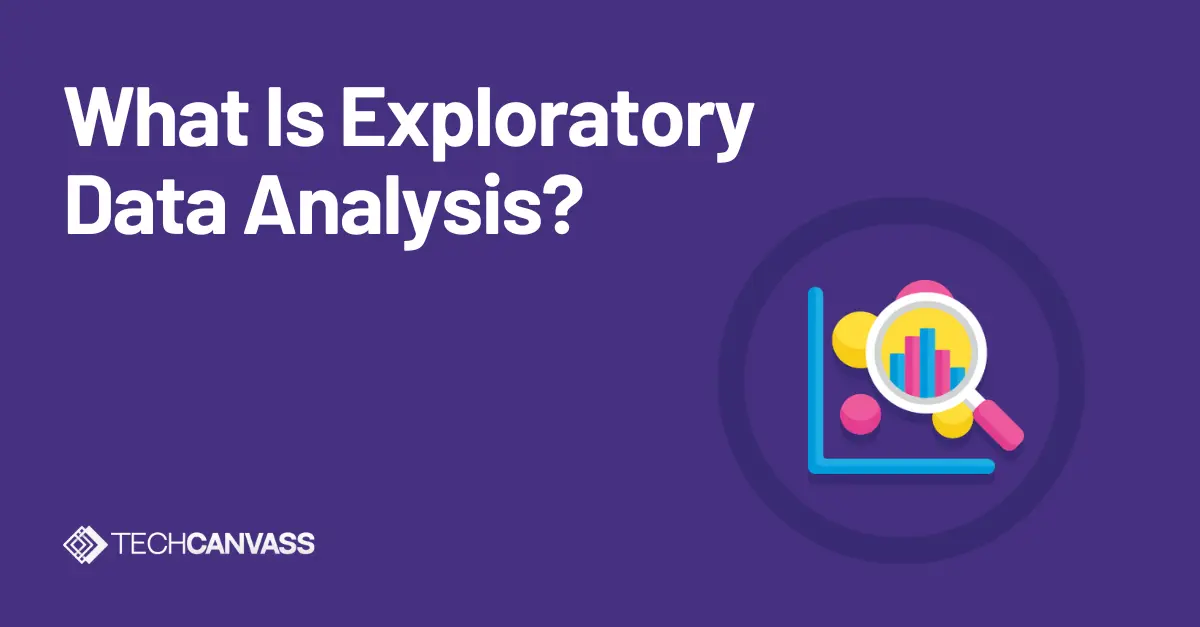Last Updated on October 15, 2024 by Techcanvass Academy
Exploratory Data Analysis (EDA)
Overview
Exploratory data analysis is used to analyze data to understand general patterns in data. It uses analysis and visualization techniques to summarize and investigate data.
EDA helps data scientists manipulate data sources to get the answers they need, and as a result making the data analysis process easy for discovering patterns, testing a hypothesis, spotting anomalies, or checking assumptions. EDA was developed by an American mathematician John Tukey in the 1970s.
This article is a tutorial on exploratory data analysis which will help you get a good understanding of this important technique in data analytics.
Why Is Exploratory Data Analysis Important?
EDA is important as it allows data scientists to analyze the data before coming to any assumptions and ensures that the results produced are valid and applicable to business outcomes and goals.
It has the following features:
- Helps identify errors
- Promotes a better understanding of patterns within the data
- Helps detect abnormal events.
- Helps understand data set variables and the relationship among them.
Moreover, exploratory data analysis can help answer questions related to standard deviations, categorical variables, and confidence intervals.
EDA Tools
Let’s have a look at the tools used to perform exploratory data analysis.
The commonly used EDA tools are as follows:
1. R
It is an open-source programming language. so, This programming language provides a free software environment for statistical computing and graphics. Data scientists or other statisticians commonly use the R language to develop statistical observations and data analysis.
2. Python
It is an interpreted, object-oriented programming language with dynamic binding. hence, It allows data scientists to spot missing values of the data set. Since analyzing a dataset is a time-consuming process, Python offers open-source modules that help automate the entire process of EDA to save time and effort. Python is an excellent tool for EDA as it offers high-level, built-in data structure, dynamic typing, and binding.
3. Excel
It is the simplest tool to start your data exploration. With many built-in functions and add-on tools, we can perform in-depth analysis.
With the help of the EDA tools described above, EDA can also perform the following statistical functions and techniques:
- Perform K-Means clustering, which is also a popular clustering method in unsupervised learning where data points are assigned into clusters or K-groups. This kind of clustering method is commonly used in pattern recognition, market segmentation, and image compression.
- EDA is used in Predictive Models such as linear regression to predict outcomes.
Useful Links – Data Analytics Certification Training | Power BI Certification Training | Tableau Training
Exploratory Data Analysis types
There are four types of EDA, they are as follows:
- Univariate Non-Graphical: This is also the simplest type of EDA among the other options. The univariate non-graphical analysis consists of only a single variable. The main objective of this type of EDA is to describe the data and find patterns within it.
- Univariate Graphical: Unlike the previous type of EDA, as the name suggests, this method provides a graphical display of the data. It involves different kinds of analysis methods, including histograms, box plots, and stem and leaf plots.
- Multivariate Non-Graphical: The multivariate non-graphical type of EDA consists of multiple variables and establishes relationships between variables using cross-tabulation or statistics.
- Multivariate Graphical: In this type of EDA, graphics display the relationship among two or more data sets. Bar charts and scatter plots are the most used charts under this category.
Process of EDA
The EDA process involves several steps. These steps are summarized below:
Data Collection and Preparation: The first step in EDA is to put all the data in one place for the next steps. Collecting data may involve gathering data from multiple sources including databases, files and even social media.
Data Cleaning: The next step is to clean the data so that it can be used. Cleaning data involves finding missing values, and de-duplicating and correcting wrong data.
Data visualization: Once the data is ready, the next step is to use visualizations to identify patterns, trends and associations. Histograms, scatter plots and other plots can be used to visualize the data. Power BI, Tableau, and Python libraries can be used for plotting the charts.
Data analysis: Analyzing data is the next step. Creating summaries, averages, and statistical analysis are some of the techniques used to analyze data. More advanced statistical techniques, such as regression or cluster analysis can also be used at this stage.
Interpretation: The last step is to interpret the data to draw insights. The exploratory data analysis has to be conducted in the context of the problem; the organization is trying to solve. This could involve drawing conclusions, making predictions, or identifying areas for further research.
If you would like to read more about the process of EDA, you can read – How To Perform Exploratory Data Analysis
Conclusion
Exploratory Data Analysis is an important part of every Data science project. EDA can be used to drive valid assumptions and data results. Techcanvass offers an Exploratory Data analysis (EDA) course to help you learn the basics.
We also offer a variety of courses in the field of Data Analytics including Data visualizations:
FAQs
1. Is EDA part of Data Wrangling?
Both EDA and data wrangling are interrelated. hence, Data wrangling is a part of the data science process, which is sitting in between exploratory data analysis (EDA) and data acquisition.
2. Why do we need EDA?
EDA is an essential process for data scientists to analyze the data before reaching final assumptions. So, It can help data scientists to identify errors, and abnormal events, promote a better understanding of patterns within the data, and help in understanding the data set variables.
3. What is EDA and why is it useful?
An EDA is a thorough investigation to uncover the underlying structure of a data set and it is useful as it helps in discovering the trends, patterns, and relationships among the data set variables.
4. What is EDA and visualization?
Exploratory data analysis (EDA) using data visualization refers to using statistical graphs or other exploratory graphs in order to analyze the data sets. Some of these graphs may include pie charts, box plots, histograms, scatter plots, correlation matrix, and much more.
5. What is the difference between explanatory and exploratory visualization?
Explanatory visualization refers to visuals created for explanatory purposes of certain workings of phenomena, whereas exploratory visualization refers to visuals created for analytic purposes in order to explore and investigate a problem.
6. Is exploratory data analysis equivalent to data visualization?
Exploratory data analysis is the process of analyzing and structuring the data. It is easy to use by data scientists and further involves identifying trends and patterns within the data. However, data visualization is the process of putting the data into visual formats such as graphs, tables, or charts for better analysis and interpretation.
7. What is EDA Excel?
Excel is one of the EDA tools for in-depth data analysis. Excel offers many built-in functions and add-on tools.
8. What is data wrangling and data cleaning?
Data wrangling refers to transforming the format of the data by converting the raw data into a more suitable and easy-to-access format, whereas data cleaning as the name suggests refers to removing inaccurate data from the data sets to make it error-free. The process of data cleaning is performed before any other data wrangling activity.
9. What is the function of data wrangling?
The primary function of data wrangling is to transform or map the raw data into another data format with the intent of making the data more appropriate for analytical purposes.
10. Which of the following are tools for data wrangling?
A few of the data wrangling tools are as follows:
Tabula, OpenRefine, R, Data Wrangler, csvkit, Python & Pandas, Mr. Data Converter



